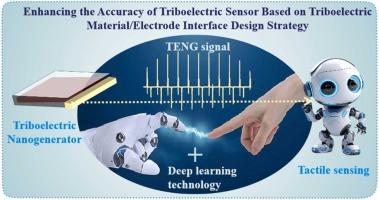基于摩擦电材料/电极界面设计策略提高摩擦电传感器精度
IF 17.1
1区 材料科学
Q1 CHEMISTRY, PHYSICAL
引用次数: 0
摘要
摩擦电纳米发电机(TENG)装置在超生物识别领域有着广泛的应用,因为当不同的材料与TENG装置表面接触时,会产生具有独特波形特征的摩擦电信号。然而,只有从传感器结构设计和工作模式优化的角度才能提高识别精度。为了解决这些问题,我们开发了一种摩擦电材料/电极界面结构设计策略,可以提高基于teng的触觉传感器的识别精度。为此,制备了一种具有弹性聚合物包封金属材料结构的新型TENG装置。制备镀铜非织造布作为电极,其特点是结构无序,纤维之间形成大量孔隙,大大增加了比表面积。在微米尺度上没有取向,避免了应力-信号特征关系的畸变。此外,弹性聚二甲基硅氧烷(PDMS)包封镀铜非织造布的结构使输出信号波形在极端环境下保持稳定,有助于提高输出电压和信号波形在极端环境下的耐久性。更重要的是,物体与摩擦电材料之间的分离和压缩导致静电电子的流动,形成独特的输出信号和自供电电源。摩擦电信号特征与材料特性之间存在着明确的内在关系。正如预期的那样,经过R-CNN模型训练后,识别不同材料和手掌的准确率分别达到了98.3%和98.75%。最后,本文为智能传感器的设计提供了可靠的策略。本文章由计算机程序翻译,如有差异,请以英文原文为准。

Enhancing the accuracy of triboelectric sensor based on triboelectric material/electrode interface design strategy
Triboelectric nanogenerator (TENG) device is widely used in the field of ultra-biometrics because triboelectric signals with unique waveform features are generated when the different materials come into contact with TENG device surface. Nevertheless, the recognition accuracy is only improved from the perspective of designing sensor structure and optimizing working mode. To address these challenges, we developed a triboelectric material/electrode interface structure design strategy that can enhance the identification accuracy of TENG-based tactile sensor. Thus, a novel TENG device with elastic polymer-encapsulated metal material structure was fabricated. Cu-plated nonwoven is fabricated and used as electrodes, which are characterized by an unordered structure with a large number of pores formed between the fibers, greatly increasing the specific surface area. There is no orientation at the micron scale, avoiding distortion of the stress-signal feature relationship. Besides, the structure of elastic polydimethylsiloxane (PDMS)-encapsulated Cu-plated nonwoven fabric results in the stability of the output signal waveform under extreme environments, which assisted in improving the durability of the output voltage and signal waveform under extreme environments. More importantly, the separation and compression between the object and triboelectric material led to the flow of electrostatic electrons and the formation of unique output signals and self-powered power. There is a clear internal relationship between the triboelectric signal feature and the material characteristics. As expected, the accuracy of identifying different materials and palms after R-CNN model training reaches 98.3 % and 98.75 %, respectively. Finally, this work provides a reliable strategy for designing smart sensors.
求助全文
通过发布文献求助,成功后即可免费获取论文全文。
去求助
来源期刊

Nano Energy
CHEMISTRY, PHYSICAL-NANOSCIENCE & NANOTECHNOLOGY
CiteScore
30.30
自引率
7.40%
发文量
1207
审稿时长
23 days
期刊介绍:
Nano Energy is a multidisciplinary, rapid-publication forum of original peer-reviewed contributions on the science and engineering of nanomaterials and nanodevices used in all forms of energy harvesting, conversion, storage, utilization and policy. Through its mixture of articles, reviews, communications, research news, and information on key developments, Nano Energy provides a comprehensive coverage of this exciting and dynamic field which joins nanoscience and nanotechnology with energy science. The journal is relevant to all those who are interested in nanomaterials solutions to the energy problem.
Nano Energy publishes original experimental and theoretical research on all aspects of energy-related research which utilizes nanomaterials and nanotechnology. Manuscripts of four types are considered: review articles which inform readers of the latest research and advances in energy science; rapid communications which feature exciting research breakthroughs in the field; full-length articles which report comprehensive research developments; and news and opinions which comment on topical issues or express views on the developments in related fields.
 求助内容:
求助内容: 应助结果提醒方式:
应助结果提醒方式:


